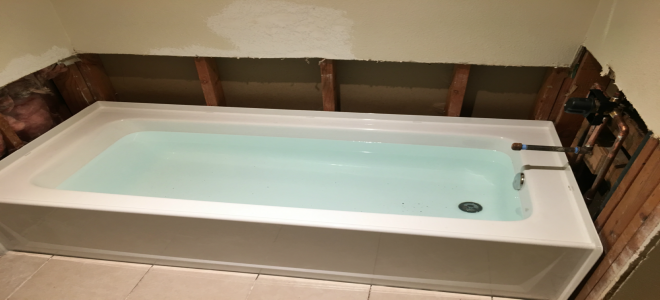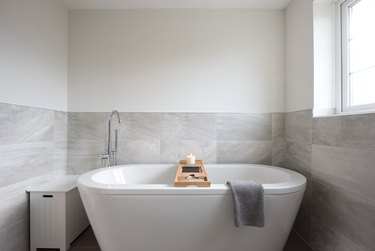Getting Started with Plumbing Basics for Bathtub Installation
Getting Started with Plumbing Basics for Bathtub Installation
Blog Article
Have you been interested in resources around A Step-by-Step Guide to Installing a Bathtub?

Setting up a tub isn't specifically brain surgery, yet it does call for strong plumbing, carpentry, and in some cases, tiling skills. Replacing an old bathtub with a new one is additionally a reasonably tough job. If the old bathtub is easily easily accessible, the job can move easily; if you need to open a wall to remove the old bathtub and also place the new bath tub, the job is much harder. In either situation, the job is within a house handyman's skills, although you will certainly require a helper to vacate the old bathtub and set in the new one. Make sure you have certified on your own for the work and are comfortable trying it. As opposed to working with a professional to take control of a halfway-completed project, it is much better to take into consideration employing one prior to you start. Possibilities are you may need a specialist plumber to make tube connections.
This post will aid you install a brand-new bath tub in your restroom if you have already bought a new bathtub and also don't require to change the arrangement of your previous water system pipelines.
Your devices as well as material checklist should comprise the following:
Planning for the Installment
Firstly, the supporting structure provided with the bath ought to be fitted (if required) according to the supplier's guidelines. Next, fit the faucets or mixer to the tub. When suitable the faucet block, it is necessary to make certain that if the faucet includes a plastic washing machine, it is fitted between the bathroom as well as the faucets. On a plastic bath, it is likewise reasonable to fit a sustaining plate under the faucets system to prevent pressure on the bathtub.
Fit the flexible faucet connectors to the bottom of the two faucets using 2 nuts and olives (sometimes provided with the bathtub). Fit the plug-hole electrical outlet by smearing mastic filler round the sink outlet hole, and after that pass the electrical outlet with the hole in the bath. Use the nut supplied by the maker to fit the plug-hole. Check out the plug-hole electrical outlet for an inlet on the side for the overflow pipeline.
Next off, fit completion of the versatile overflow pipeline to the overflow outlet. After that, screw the pipe to the overflow face which must be fitted inside the bath. See to it you make use of every one of the supplied washers.
Connect the catch to the bottom of the waste electrical outlet on the bath tub by winding the string of the waste electrical outlet with silicone mastic or PTFE tape, and screw on the trap to the electrical outlet. Link all-time low of the overflow tube in a comparable manner.The bath ought to currently be ready to be fitted in its last setting.
Removing Old Touches
If you need to replace old faucets with new ones as a part of your installation, then the first thing you should do is separate the water. After doing so, switch on the taps to drain pipes any type of water remaining in the system. The procedure of eliminating the existing faucets can be quite troublesome as a result of the limited access that is commonly the case.
Utilize a container wrench (crowsfoot spanner) or a faucet device to reverse the nut that links the supply pipes to the taps. Have a cloth ready for the remaining water that will originate from the pipelines. Once the supply pipelines have been eliminated, use the very same device to loosen the nut that holds the faucets onto the bath/basin. You will need to stop the single taps from transforming during this process. As soon as the taps have actually been eliminated, the holes in the bath/basin will certainly have to be cleansed of any type of old sealing substance.
Before moving on to fit the new faucets, compare the pipe connections on the old taps to the brand-new taps. If the old taps are longer than the brand-new taps, after that a shank adapter is required for the new faucets to fit.
Installing the Tub
Making use of both wood boards under its feet, put the bath tub in the required placement. The wood boards are helpful in equally spreading out the weight of the bath tub over the location of the boards rather than concentrating all the weight onto four little points.
The next goal is to make sure that the bath tub is leveled all round. This can be accomplished by checking the level and readjusting the feet on the bath tub up until the spirit level checks out level.
To mount faucets, fit the bottom of the outermost versatile tap adapter to the proper supply pipeline by making a compression join; then do the very same for the other faucet.
Turn on the supply of water and inspect all joints as well as new pipework for leaks and also tighten them if required. Load the tub as well as also examine the overflow electrical outlet and the typical electrical outlet for leakages.
Finally, take care of the bathroom paneling as described in the supplier's instruction manual. Tiling as well as sealing around the tub needs to wait until the bathtub has been utilized at the very least when as this will settle it into its final position.
Fitting New Taps
If the tails of the new faucets are plastic, after that you will certainly need a plastic connector to prevent damages to the string. One end of the adapter fits on the plastic tail of the faucet and the various other end offers a connection to the current supply pipelines.
If you need to fit a monobloc, then you will certainly call for lowering couplers, which links the 10mm pipe of the monobloc to the conventional 15mm supply pipe.
Next off, place the tap in the mounting opening in the bath/basin making sure that the washers remain in place between the faucet and the sink. Secure the faucet in place with the supplier offered backnut. As soon as the tap is safely in position, the supply pipes can be linked to the tails of the taps. The taps can either be attached by utilizing corrugated copper piping or with typical faucet adapters. The former kind should be linked to the faucet finishes first, tightening up only by hand. The supply pipes can later be linked to the various other end. Tighten up both ends with a spanner after both ends have actually been connected.
Tiling Around the Bathtub
In the area where the bath meets the tile, it is needed to secure the joins with a silicone rubber caulking. This is necessary as the installation can move sufficient to crack a rigid seal, triggering the water to permeate the wall between the bath and also the tiling, bring about difficulties with wetness and feasible leakages to the ceiling listed below.
You can pick from a range of coloured sealers to blend in your fixtures and installations. They are offered in tubes and cartridges, and can sealing gaps approximately a size of 3mm (1/8 inch). If you have a larger void to fill, you can load it with twists of drenched newspaper or soft rope. Remember to always fill up the bathtub with water prior to sealing, to permit the movement experienced when the tub remains in use. The sealant can fracture relatively very early if you do not consider this activity prior to securing.
Conversely, ceramic coving or quadrant ceramic tiles can be used to edge the bath or shower tray. Plastic strips of coving, which are easy to use and cut to dimension, are likewise conveniently readily available on the marketplace. It is advisable to fit the tiles utilizing water-resistant or water resistant sticky and cement.
Bathtub Installation
How Important Is A Bathtub To Your Home?
High-quality baths, showers, and other bathroom updates are necessary when considering a smart investment in your home. It’s a room that you go to every day and one that is constantly being used by guests.The bathroom is one of the top trafficked rooms in a home and also one of the most valuable in terms of home resale.
Install Piping Before Tub
You will be using your existing drain and waste vent system, but pipes required include the hot and cold water supply lines and a pipe leading to a shower head. A mixing valve and shower head are also needed. Air chambers may be required.
Position the Tub
Lower the tub into place so that the continuous flange fits against the wall studs and rests on 1’x4' or 2’x4' supports. Anchor the tub to the enclosure with nails or screws inserted through the flanges into the studs.
NOTE: Remember, bathtubs and shower stalls may require support framing. A bathtub filled with water is extremely heavy, so check building codes and framing support before installing the tub.
Assemble Drain Connections
Assemble the bathtub drain connections by connecting the tub overflow with the tub drain above the trap, not beyond it. The trap will have a compression fitting that screws over the arm of the overflow assembly.
Place a Pipe For the Shower Head
First, locate a brass female threaded winged fitting and attach it to a framing support via a screw or a nail. Then run a pipe up the wall for the shower head. Sweat or solder the other side of the brass fitting to the top of the pipe.
Attaching Hot and Cold Water Lines
Attach your water lines for both hot and cold by sweating these directly into the hot and cold ports of the mixing valve. The mixing valve will be how water enters the tub’s system, not by the pipes themselves.
Install the Spout
Extend a piece of 1/2 inch pipe, or whichever length is specified in the manufacturer’s instructions, for the tub spout. Sweat on a male threaded fitting at the end of the pipe or use a brass nipple of the proper length and a 1/2 inch cap.
NOTE: At this point you should have your rough-in plumbing work inspected before proceeding further.
Check For Leaks
Restore the water pressure and check the drain connection and the supply pipes for any sign of leaking.
estore the Bathroom Wall
Replace the wall with moisture-resistant drywall as a base for your wall covering. Seal the joints between the wall and your new tub with silicone caulk as protection against water seepage.
https://www.berkeys.com/2016/12/02/bathtub-installation-dallas/

As an enthusiastic reader on How to Install a Bathtub Yourself, I assumed sharing that excerpt was essential. Kindly take a moment to distribute this blog entry if you enjoyed reading it. I praise you for your time. Please check up our website back soon.
For quick relief, contact! Report this page